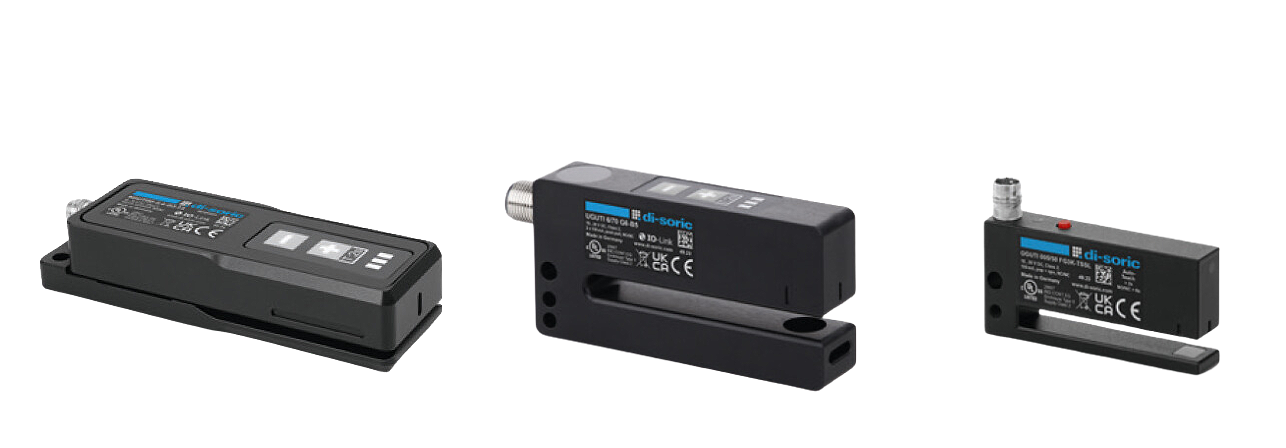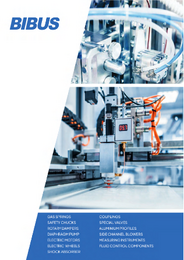label sensors for production, dispensing and inspection of labels

Label sensors are designed to dispense various labels quickly, precisely, and flexibly. The increasing variety of labels, such as wafer-thin, transparent, or partially metallized labels, as well as booklets with integrated package inserts, requires sensors to adapt for safe and accurate detection and application. Selecting the appropriate functional principle—capacitive, optical, or ultrasonic—enables optimized detection results across different label materials.
di-soric label sensors feature auto-teach functionality for easy setup, allowing users to determine the ideal switching point by pressing a button while the label tape moves through the sensor. This auto-teach capability supports fast adaptation to new label materials and can also be controlled remotely or via IO-Link.
Types of label sensors:
- KGUTI: Capacitive label sensors
- OGUTI: Optical label sensors
- UGUTI: Ultrasonic label sensors
Capacitive Label Sensors - KGUTI
KGUTI capacitive label sensors provide a cost-effective and high-performance solution for detecting thin, transparent, film, and paper labels. They are particularly suitable for high tape speeds and feature an intuitive auto-teach function for quick adaptation to new materials. Two models are available: the space-saving KGUTI50 with 1 mm or 0.4 mm fork widths, and the KGUTI80, designed for wide labels with an 85 mm fork depth.
Key Features:
- Precise Detection: High reproducibility for detecting thin labels.
- Two Models:
- KGUTI80: Suitable for wide labels.
- KGUTI50: Compact design with narrow fork widths for demanding materials.
- Intuitive Auto-Teach: Teach-in and fine adjustment via membrane keypad with 3 LEDs for status, output, and diagnostics.
- Push-Pull Output: Supports both pnp and npn functions in one device.
- Robust Metal Housing: Separable for easy cleaning, with a metal plug connector.
- Digital Compatibility: Supports IO-Link for digitization and parallel switching output.
Applications:
- Label Detection and Positioning: Ideal for detecting thin, transparent film labels at high tape speeds, especially in vertical labeling machines.
- Triggering Image Processing Systems: Used in inspection systems to precisely trigger camera systems for 100% label checks at high tape speeds.
Optical Label Sensors – OGUTI
OGUTI optical label sensors are designed for the fast and precise detection of thin and thick paper labels at high tape speeds, offering a cost-effective solution for various labeling needs. Their compact construction allows installation near the dispensing edge, and the intuitive auto-teach function supports easy product changes during operation. The OGUTI series comes in three models with fork openings of 2-5 mm and fork depths of 40-100 mm.
Key Features:
- High-Speed Detection: Suitable for tape speeds up to 500 m/min.
- Maximum Dispensing Precision: Ensures exact label identification with high reproducibility, allowing only ±0.05 mm deviation.
- Intuitive Auto-Teach: Simple product changes during operation via the operating button.
- Installation Flexibility: Can be installed near the label dispensing edge due to the flat leg design.
- Robust Construction: Features a durable metal housing and metal plug connector.
- Large Fork Width Options: Suitable for detecting both thin and thick labels, including thick booklets with integrated inserts.
- Wide Label Compatibility: Models available with fork widths up to 100 mm (e.g., OGUTI 005/100).
Applications:
- Punching and Label Detection: Accurately detects labels after automated punching, even at very high tape speeds.
- Label Detection and Positioning: Provides an economical solution for precise positioning of paper labels, ideal for high-performance labelers due to its ability to install close to the dispensing edge.
Ultrasonic Label Sensors – UGUTI
UGUTI ultrasonic label sensors provide a versatile and robust solution for detecting various label materials, including very thin, transparent, and metallized labels, as well as thicker booklets. Their innovative dual operating design allows for configuration and diagnostics via IO-Link or manual threshold adjustment with auto-teach. They are suitable for high-speed labeling with quick response times and precise detection.
Key Features:
- Wide Material Compatibility: Suitable for nearly all label types, including metallized film, transparent labels, paper labels, and booklets up to 5.9 mm thick.
- Precise Detection: Fast response time of 0.25 ms and tape speeds of up to 250 m/min, with high reproducibility.
- Flexible Design: Features ultrasound technology with a 6 mm fork width and a 70 mm fork depth to handle a variety of label materials and sizes, including short labels as small as 2 mm.
- Rugged Construction: Compact design with metal housings and straight or angled plug connectors, plus easy cleaning with a blow-out hole.
- Intuitive Auto-Teach: Teach-in and fine adjustment via a membrane keypad with LEDs for status, output, and diagnostics.
- Ready for Digitization: Supports IO-Link for digital integration and parallel operation switching output.
Applications:
- Detecting and Positioning Labels: Suitable for detecting both thin and booklet labels on various surfaces, such as containers with transparent design labels and booklet labels with instructions.
- Universal Use for Different Label Materials: Provides reliable detection for frequently changing label materials, including thin, thick, transparent, film, paper, and metallized labels, making it highly adaptable for diverse labeling applications.
Enabling Industry 4.0 with IO-Link Integration
The adoption of IO-Link technology in label sensors marks a significant step toward Industry 4.0, the smart factory concept. IO-Link is a global communication standard (IEC 61131-9) that allows sensors and actuators to become intelligent devices. Through IO-Link integration, label sensors provide real-time data and diagnostics, enabling more transparent, flexible, and efficient production processes. This digital transformation helps manufacturers optimize operations, reduce downtime, and increase cost-effectiveness.










